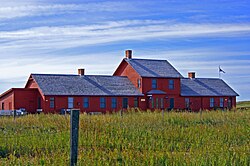Galts' narrow gauge railway

NWC&NC built the steamboat 'Baroness' along with a number of barges in 1883 to ship coal to Medicine Hat, by the Oldman River. However, this soon proved to be impractical, as the time of navigable high water was short and undependable, and shoals and sandbanks proved hazardous. Only 3200 tons of coal was delivered to Medicine Hat in two years. Sir Alexander Galt had already conceived the idea of a narrow gauge railway, and in 1884 the Federal government confirmed the British charter, and empowered the NWC&NC to build a 3 ft (914 mm) narrow gauge railway from Dunmore, Alberta, to its coal properties at Lethbridge. NWC&NC contracted Canadian Pacific Railway to buy a minimum of 20,000 tons of coal a year for five years at $5 a ton delivered to Medicine Hat. Canada's Governor General, the Marquis of Landsdowne, demonstrated the Dominion government's support of the Galt enterprises, by opening the Galts' narrow gauge railway on October 19, 1885, in Lethbridge. [1] [2]
Alberta Railway & Coal Company
| Overview | |
|---|---|
| Locale | Lethbridge, Alberta to Great Falls, Montana |
| Dates of operation | 1889–1912 |
| Technical | |
| Track gauge | 1,435 mm (4 ft 8+1⁄2 in) standard gauge |
In 1889, the Alberta Railway & Coal Company was incorporated by NWC&NC to build a 3 ft (914 mm) narrow gauge railway from Lethbridge to the Canada–United States border, a distance of 65 miles. Coincident with the building of the AR&CC line in 1890, the Galts received a Montana charter for the narrow gauge Great Falls and Canada Railway (GF&CR). The 3 ft (914 mm) line ran from Sweetgrass, opposite Coutts, to Great Falls, Montana. By extending their railway into the United States, the Galts were able to enlarge the market for Lethbridge coal. In 1901, the GF&CR line was converted to standard gauge, and was purchased by the Montana Great Northern Railway, a subsidiary of the Great Northern Railway (U.S.).
Originally leased to the CPR in 1893, the line from Dunmore to Lethbridge (the AR&CC had acquired the properties of the NWC&NC in 1891), the line was upgraded to standard gauge, and was purchased outright in 1897 and became the first leg of the Crow's Nest Pass branch railway to the CPR's mineral properties in the Kootenay area of south-eastern British Columbia, with the right to extend the line to Hope.
Alberta Railway & Irrigation Company

To further the AR&CC's aims to develop the granted land and attract settlement, Elliott Galt was made aware that farming, not ranching, was the appropriate means of development, and Irrigation was the key. He was approached by Charles Ora Card of the Utah-based Church of Jesus Christ of Latter-day Saints, who detailed his vision of using the local river systems for irrigation. Card had visited Canada in 1886 and had returned in 1887 with a group that settled on Lees Creek and established the village of Cardston, Alberta. Under Brigham Young, the Mormons had established a thriving community centered on Salt Lake City and had pioneered and gained expertise in farming by irrigation in an area of deficient rainfall.
An agreement was reached with the Mormons in 1891, whereby they would lease 700,000 acres of land, bring in settlers, and provide labour for building the canal system. Economic depression and the lack of capital ended the project. Though temporarily thwarted the Galts continued to pursue their plan for irrigation and soon afterwards, with an upturn in the economy and a new Liberal Party of Canada, government with Clifford Sifton, as Minister of the Department of the Interior, who pursued a vigorous policy of Immigration, the fortunes of the Galt enterprises changed for the better. An agreement was reached with the Government of Canada, whereby in an exchange of lands the AR&CC was able to assemble a solid block of 500,000 acres adjacent to the St. Mary River thus making large-scale irrigation feasible. A new contract was signed with the Mormons in which they were to construct the canal system and in return for their labour they were to be paid "one-half in cash and one-half in land, the land with water rights being valued at three dollars per acre, to a total of $75,000 and 25,000 acres. A remission of the survey fee of ten cents per acre was also granted by the government. The church-sponsored immigrants, to whom Galt advanced the costs of transportation, were to establish themselves in hamlet, one each in the tracts twenty and thirty miles south of Lethbridge, the communities of Stirling & Magrath, Alberta were established in 1889 as per contract with AR&IC. The main canal was completed in August 1900.
That same year the St. Mary’s River Railway Company was incorporated to provide access and serve the settlers benefiting from the irrigation system. It reached Cardston in 1903, with permission to extend the 3 ft (914 mm) narrow gauge line. At Raymond, Alberta a sugar beet factory was erected. A further consolidation of land took place in 1900, followed in 1902 by the purchase of the adjacent 500,000 Acre Tract at one dollar an acre after the awarding of credits amounting to two dollars an acre. Payment was to be made in ten equal annual installments. The stipulation was that the land could not be sold for more than five dollars an acre, and the unsold balance, after 15 years, would revert to the government. In 1904 the Galt companies were merged into a new corporation, the Alberta Railway and Irrigation Company (AR&IC). The St. Mary's Canal was enlarged and a beginning was made on a canal from the Milk River, halted by the Boundary Waters Treaty of 1909 between the United States and Canada, dividing the waters of the two rivers equally between the two countries. In 1912 the Canadian Pacific Railway leased the AR&IC for 999 years thus ending the independence of the Galt enterprise.